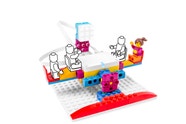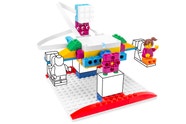High-Tech Playground
What do you think a high-tech playground would look like? Help Maria to design something new for her friends!

Prepare
- Review the High-Tech Playground lesson in the LEGO® Education SPIKE™ App.
- Consider the abilities and backgrounds of all your pupils. Differentiate the lesson to make it accessible to everyone. Please refer to the Differentiation section below for suggestions on how to do this.
- If time permits, plan and facilitate the language arts extension. Please refer to the Extension section below for further information.
Engage
(Whole Class, 5 Minutes)
- Facilitate a quick discussion about making changes and improvements to an everyday object.
- Talk with your pupils about some objects around your school that they would like to improve.
- Ask questions like these: What object from around our school would you like to improve? What would you change about it?
- Introduce your pupils to the story’s main characters and the first challenge: rocking the seesaw.
- Distribute a brick set and a device to each group.
Explore
(Small Groups, 30 Minutes)
- Have your pupils use the LEGO® Education SPIKE™ App to guide them through their first challenge:
- Create and test the program that rocks the seesaw.
- Have your pupils iterate and test their models to complete the next two challenges in the app:
- Modify the program to make the seesaw more exciting.
- Design your own upgraded seesaw.
- You can find coding and building help in the Tips section below.
Explain
(Whole Class, 5 Minutes)
- Gather your pupils together to reflect on their completed challenges.
- Ask questions like these: How did you program the seesaw to make it high tech? How did your changes make the seesaw more fun for Maria?
Elaborate
(Whole Class, 5 Minutes)
- Prompt your pupils to discuss and reflect on ways of using the design process to improve an existing object.
- Ask questions like these: What happens when you try to improve something but your first idea does not work as you had hoped? How can you adjust your idea to make it successful?
- Have your pupils tidy up their workstations.
Evaluate
(Ongoing Throughout the Lesson)
- Ask guiding questions to encourage your pupils to ‘think aloud’ and explain their thought processes and reasoning in the decisions they have made while building and programming their models.
Observation Checklist
- Measure your pupils’ proficiency in using the design process to improve an existing object.
- Establish a scale that suits your needs. For example:
- Requires additional support
- Can work independently
- Can teach others
Self-Assessment
Have each pupil choose the brick that they feel best represents their performance.
- Yellow: I think that I can use the design process to improve an existing object.
- Blue: I can use the design process to improve an existing object.
- Green: I can use the design process to improve an existing object, and I can also help a friend to do it.
Peer Feedback
- In their small groups, have your pupils discuss their experiences working together.
- Encourage them to use statements like these:
- I liked it when you…
- I would like to hear more about how you…
Tips
Coding Tips
- After your pupils have completed their first challenge, they will be provided with a map.
- Using the map, your pupils can experiment with the available Coding Blocks to modify their programs to follow the route for the trip.




Model Tip
- After your pupils have completed their second challenge, they will be provided with three Inspiration Images and an open-ended prompt, which will help them to improve their models.
- The Inspiration Images are meant to help spark their imaginations as they experiment and personalise their models.




There are no specific building instructions for this challenge.
Differentiation
Simplify this lesson by:
- Selecting one Inspiration Image to help your pupils personalise their models
- Experimenting with either the coding or the building
Increase the difficulty by:
- Having your pupils interview each other about the features they would like a seesaw to have, then designing one that meets those specifications
- Exploring new and different coding blocks within the program
Extension
- Have your pupils write an opinion piece on whether there should be a playground at their school. Make sure that they give a clear argument that is supported by facts and details.
If facilitated, this will extend beyond the 45-minute lesson.
ACELA1490
Understand how texts vary in complexity and technicality depending on the approach to the topic, the purpose and the intended audience
Teacher Support
The pupils will:
- Use the design process to improve an existing object
- Develop, test, and refine prototypes as part of a design process
- Engage effectively in a range of collaborative discussions
(one for every two pupils)
- LEGO® Education SPIKE™ Essential Set
- Device with the LEGO® Education SPIKE™ App installed
Design and Technologies
ACTDEP017
Evaluate design ideas, processes and solutions based on criteria for success developed with guidance and including care for the environment.
Digital Technologies
ACTDIP013
Plan, create and communicate ideas and information independently and with others, applying agreed ethical and social protocols.
English Language
ACELA1490
Understand how texts vary in complexity and technicality depending on the approach to the topic, the purpose and the intended audience.